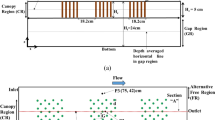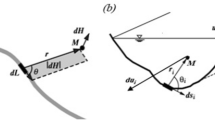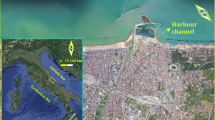Abstract
The most widely used method of flushing of reservoirs is to remove the deposited sediment through the bottom outlets. The size and shape of gates affect the outflow volume of water, the volume of removed sediments, and flushing efficiency. The purpose of this study is to investigate the effect of the area, number and shape of the bottom outlet gates on the velocity, concentration, and volume of the removed sediments and the dimensions of the flushing cone. Four different shapes with the same area were used for this purpose. Moreover, to study the effect of area and number of gates on flushing efficiency, circular gates with two different diameters were used. In this research, various pressure flushing modes were simulated using the Flow-3D model. Calibration and evaluation of this model were performed based on experimental findings. Results showed the parameters of the Flow-3D measures such as length, width, maximum depth, and flushing cone size with an average error of 3%, which is in good agreement with experimental results. As the area of the outlet gates increases, flushing is less risky in viewpoints of the operation process. Furthermore, the gate with a horizontal-rectangular section has an optimal shape with the highest flushing efficiency.










Similar content being viewed by others
References
Atkinson E (1996) The feasibility of flushing sediment from the reservoir. Report OD 137. Wallingford.
Brandt SA (2000) A review of reservoir desiltation. International Journal of Sediment Research. 15:321–342
Brethour J (2003) Modeling sediment scour. Flow Science Inc. Report FSI-03-TN62
Brethour J, Burnham J (2010) Modeling sediment erosion and deposition with the FLOW-3D sedimentation & scour model. Flow Science Technical Note. FSI-10-TN85, pp: 1-22.
Dawdy DR, Vanoni VA (1986) Modeling alluvial channels. Water Resources Research. Vol. 22(9S):71S–81S
Dehghani AA, Mosaedi A, Imamgholizadeh S, Meshkati ME (2010) Experimental investigation of pressure flushing technique in reservoir storages. Application Plans of the Ministry of Energy
Epely-Chauvin G, De Cesare G, Schwindt S (2014) Numerical modelling of plunge pool scour evolution in non-cohesive sediments. Engineering Applications of Computational Fluid Mechanics. 8(4):477–487. https://doi.org/10.1080/19942060.2014.11083301
Esmaeili T, Sumi T, Kantoush SA, Kubota Y, Haun S, Rüther N (2017) Three-dimensional numerical study of free-flow sediment flushing to increase the flushing efficiency: a case-study reservoir in Japan. Water. Vol. 9. No. 11, p. 900. https://doi.org/10.3390/w9110900 .
Fang D, Cao S (1996) An experimental study on scour funnel in front of a sediment flushing outlet of a reservoir. Proceedings of the 6th Federal Interagency Sedimentation Conference. Las Vegas. March 10-14, pp: I.78-I.84.
Hemphil RG (1931) Silting and life of southwestern reservoirs. Proceedings of the American Society of Civil Engineers. 56(5):967–980
Holly FM, Cunge JA (1975) Time dependent mass dispersion in natural streams. In: Modelling Techniques. ASCE, San Francisco, pp 1121–1137
Huan CC, Lai JS, Lee FZ, Tan Y C (2018) Physical model-based investigation of reservoir sedimentation processes. Water. Vol. 10, No. 4, p. 352. https://doi.org/10.3390/w10040352.
Khosronejad A, Rennie CD, Neyshabouri AS, Gholami I (2008) Three-dimensional numerical modeling of reservoir sediment release. Journal of Hydraulic Research. 46(2):209–223. https://doi.org/10.1080/00221686.2008.9521856
Lai JS, Shen HW (1996) Flushing sediment through reservoirs. Journal of Hydraulic Research. 34(2):237–255. https://doi.org/10.1080/00221689609498499
Lyn H (1987) Unsteady sediment transport modeling. Journal of Hydraulic Engineering. ASCE 110(4):450–466
Meshkati ME, Dehghani AA, Naser G, Emamgholizadeh S, Mosaedi A (2009) Evolution of developing flushing cone during the pressurized flushing in reservoir storage. World Academy of Science. Engineering and Technology 58:1107–1111
Morris GL (1995) Reservoir sedimentation and sustainable development in India: problem scope and remedial strategies. Sixth International Symposium on River Sedimentation, Management of Sediment: Philosophy, Aims, and Techniques, New Delhi.
Morris GL, Fan J (1998) Reservoir sedimentation handbook: design and management of dams, reservoirs, and watersheds for sustainable use. McGraw Hill, New York. USA
Movahedi A, Kavianpour MR, Yamini OA (2018) Evaluation and modeling scouring and sedimentation around downstream of large dams. Environmental Earth Sciences 77:1–17. https://doi.org/10.1007/s12665-018-7487-2
Petkovšek G, Roca M, Kitamura Y (2020) Sediment flushing from reservoirs: a review. Dams and Reservoirs. 30(1):12–21. https://doi.org/10.1680/jdare.20.00005
Sawadogo O, Basson GR, Schneiderbauer S (2019) Physical and coupled fully three-dimensional numerical modeling of pressurized bottom outlet flushing processes in reservoirs. International Journal of Sediment Research. 34:461–474. https://doi.org/10.1016/j.ijsrc.2019.02.001
Scheuerlein H, Tritthart M, Nunez-Gonzalez F (2004) Numerical and physical modeling concerning the removal of sediment deposits from reservoirs. Conference proceeding of Hydraulic of Dams and River Structures, Tehran, Iran, pp 245–254
Török GT, Baranya S, Rüther N (2017) 3D CFD modeling of local scouring, bed armoring and sediment deposition. Water. Vol. 9, No. 1, p. 56, https://doi.org/10.3390/w9010056.
White WR, Bettess R (1984) The feasibility of flushing sediments through reservoirs. challenges in African hydrology and water resources Proceedings of the Harare Symposium, IAHS Publication, No.144, pp. 577-587.
Xie Z (2011) Theoretical and numerical research on sediment transport in pressurized flow conditions. The University of Nebraska-Lincoln.
Yucel O, Graf WH (1973) Bed load deposition and delta formation: a mathematical model. December 1973. Fritz Laboratory Reports. 2062.
Author information
Authors and Affiliations
Corresponding author
Additional information
Responsible Editor: Murat Karakus
Rights and permissions
About this article
Cite this article
Sadat Helbar, M., Parvaresh Rizi, A., Farhoudi, J. et al. 3D flow simulation to improve the design and operation of the dam bottom outlets. Arab J Geosci 14, 90 (2021). https://doi.org/10.1007/s12517-020-06378-4
Received:
Accepted:
Published:
DOI: https://doi.org/10.1007/s12517-020-06378-4




